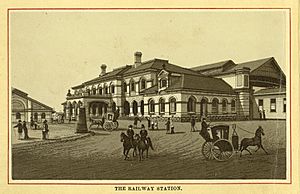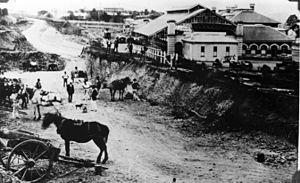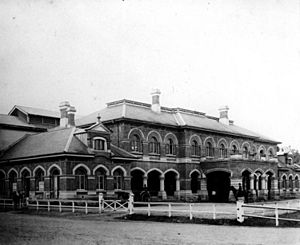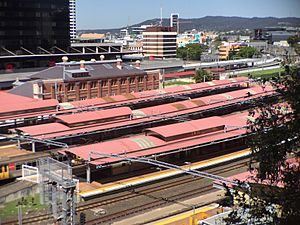1873 Roma Street railway station building facts for kids
Quick facts for kids 1873 Roma Street railway station building |
|
|---|---|

Roma Street railway station, circa 1883
|
|
| Location | 159 Roma Street, Brisbane CBD, City of Brisbane, Queensland, Australia |
| Design period | 1870s - 1890s (late 19th century) |
| Built | 1873 - 1940s circa |
| Architect | Francis Drummond Greville Stanley |
| Architectural style(s) | Classicism |
| Official name: Roma Street Railway Station, Brisbane Passenger Station, Brisbane Terminal Station, Brisbane Terminus | |
| Type | state heritage (built) |
| Designated | 24 March 2000 |
| Reference no. | 601208 |
| Significant period | 1870s-1910s (historical) 1870s-1910s (fabric) 1870s-ongoing (social) |
| Significant components | foyer - entrance, office/s, views to, railway siding, railway station, furniture/fittings, platform, platform canopies/awnings (railway), ticket box/office |
| Builders | John Petrie |
| Lua error in Module:Location_map at line 420: attempt to index field 'wikibase' (a nil value). | |
The 1873 Roma Street railway station building is a historic building in Brisbane, Queensland, Australia. It was one of the first major railway stations built in the city. Designed by Francis Drummond Greville Stanley and built by John Petrie between 1873 and 1875, it is also known as Brisbane Passenger Station or Brisbane Terminus. This important building is listed on the Queensland Heritage Register.
Contents
The Start of Queensland's Railways
The first Roma Street railway station was built between 1873 and 1875. It was the main station in Brisbane for the Main Line and connected to the Southern and Western lines through Toowoomba.
In 1863, the Queensland Parliament passed a law called the Railway Act. This law allowed the first railways to be built in Queensland. Before this, in 1861, a company called the Moreton Bay Tramway Company had already built a wooden tramway between Ipswich and Toowoomba. At first, many people thought building railways in Queensland wouldn't work because there weren't many people living there.
Connecting Towns by Rail
The first part of the Main Line railway opened in 1865. It ran between Ipswich and a small town called Bigge's Camp, now known as Grandchester. This was the first step to connect major towns on the Darling Downs by train.
- The second part linked Ipswich to Toowoomba in 1867.
- The third part, the Western railway line, connected Toowoomba to Dalby in 1868.
- The final part, the Southern railway line, linked Toowoomba to Warwick in 1871.
Ipswich vs. Brisbane: Where Should the Railway End?
When the railway ended in Ipswich, goods had to be moved to ships there to reach Brisbane. The people of Ipswich liked this because it made their town an important port. They didn't want the railway to extend to Brisbane, as this would make Brisbane the main port instead.
However, the Queensland Government decided to survey a railway line between Ipswich and Brisbane in 1865. By 1872, a special report suggested that the railway should definitely be extended into Brisbane. The government agreed, and plans were made for the new line. It was estimated to cost about £192,000.
Queensland decided to use a narrow railway track size, 3 feet 6 inches wide. This was different from other states, showing that Queensland wanted to build railways and stations in a way that was both useful and affordable. On January 30, 1873, the Queensland Governor, George Phipps, 2nd Marquess of Normanby, officially started the work on the railway extension to Brisbane.
Building the Roma Street Station
Originally, a large iron station building from Britain was planned for Roma Street. But because the state's economy slowed down in the late 1860s, a smaller station was built instead. This new design was created by FDG Stanley in 1873-1875. Some parts of the iron building that were already on their way from London were used for other projects.
In October 1873, an announcement appeared for building the new railway station in Brisbane. FDG Stanley, who was in charge of public buildings, designed it. John Petrie's company won the bid on December 1, 1873, and the building was finished over the next two years.
The Brisbane Courier newspaper described the new station in 1873:
- It would be built near the Grammar School, facing Roma Street.
- The style would be "Italian Gothic," using brick with stone details for strength and cost-effectiveness.
- The main building would have two floors, with one-story sections on each side.
- The ground floor would have ticket offices, the station master's office, and waiting rooms.
- The upper floor would be for the railway staff.
The railway line reached Oxley Point (now Chelmer railway station) by February 1875. However, the bridge over the Brisbane River to Indooroopilly wasn't ready yet. Trains had to be moved across the river on special boats. Even though it wasn't fully finished, the line from Ipswich to Brisbane officially opened on June 14, 1875. At the opening, parts of the station were still incomplete.
The station was designed to hold staff and facilities for train travel, including a station master, ticket office, and waiting rooms. A large goods shed was added in 1875-1876, and more tracks were built. In 1876, a railway bridge was planned over Countess Street to help with road traffic.
Changes Over the Years
The Roma Street railway station has changed a lot over time.
- In 1911, the entire railway yard at Roma Street was reorganized.
- In the early 1940s, a new "Country Station" was built between the original station and Roma Street. This meant the old station could no longer be reached directly from Roma Street. The new station helped ease crowding at Brisbane Central Station and became the main station for long-distance travel.
- In the 1980s, a large building called the Brisbane Transit Centre was constructed. This included new railway facilities, a hotel, and offices. The 1940s station building was taken down to make way for this.
- In the mid-1990s, the platforms were changed and extended again.
By the early 2000s, the original station building was in poor condition. In 2012, Queensland Rail hired architects to fix the outside of the building. They put on a new slate tile roof, just like the original one, and removed later additions. This work helped restore the station building to its original look.
What the Station Looks Like
The 1873 Roma Street railway station is a strong building made of stone-like material. It sits between the newer Roma Street railway station (inside the Travelodge tower) and the train platforms behind it. Some of the platform awnings from the 1940s are still there, along with parts of the old gardens.
The station building has two floors. When it was first built, platforms were only on the back (north) side. Platforms were added to the front (south) side after the 1940 renovation. At the east end of the building, there's a large, open space with an iron roof and steel frame.
The building was originally made of brick with a central two-story section and one-story sections on each side. The roof is now made of corrugated sheeting, but it used to be slate tiles. The outside of the building has been painted.
The station was designed with a classical style, meaning it has balanced shapes and features like arches and columns. It has round and square windows, decorative moldings, and columns that separate the openings. Although it was described as "Italian Gothic" when new, it is a good example of the late Victorian Italianate style.
The central part of the building has a covered entrance area called a porte cochere on the south side. This area has columns and arches. A second story was added to this entrance later. The upper floor of the central part has five round-arched windows. The windows on the south side are generally wooden, while those on the north side are aluminum sliding windows.
The north side of the building was originally an inside wall, facing the old carriage shed. It has windows and doors that are not evenly spaced on the ground floor, but the upper floor has evenly spaced square-arched windows.
Inside, the ground floor has several rooms opening from the original arched walkway on the south side. Stairs at both ends lead to the upper floor. The upper floor has a large central hallway with arched doorways, leading to many big rooms.
The ground floor has a concrete floor in the middle and wooden floors at the ends. The main hall was divided into two parts, likely for first and second-class passengers. Other rooms on this floor were smaller offices. Many old pieces of furniture and fittings are still there, like special cupboards and an early station names board, which help us understand the building's railway history. There are also large public restrooms at each end of the ground floor.
The upper floor was used for staff offices. The eastern staircase is a narrow wooden stair from the mid-20th century, while the western stair is an older wooden one. The central hallway on the first floor leads to many bright office spaces. Skylights help bring in more light. The walls and ceilings on the upper floor are made of lath and plaster. This floor has more decorative details, like molded arches and decorative trim. You can still see early paint colors in many places.
Why This Place is Important
The 1873 Roma Street railway station building is important for several reasons:
- History of Queensland: It was the first main railway station in Brisbane and shows how railways developed in Queensland. It was also the main office for railway management in the 1870s and 1880s, overseeing the building of train lines across the state. It shows how Queensland grew in the 1870s with the construction of important public buildings and services.
- Design and Purpose: The station shows the main features of a large railway station in Queensland. Its design and layout clearly show its past uses, with areas for waiting rooms, ticket offices, public facilities, and offices. It's also a great example of the public work of a well-known Queensland architect, FDG Stanley.
- Beauty and Design: The building is a significant example of the public work of the famous Queensland architect, FDG Stanley.
- Community Connection: The 1873-1875 Roma Street railway station has been used by the public for over 120 years. Even though the area around it has changed a lot, the surviving station helps us understand how the site developed over time.




